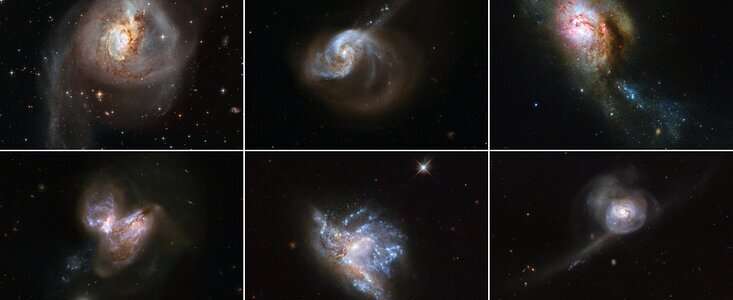To celebrate a new year, the NASA/ESA Hubble Space Telescope has published a montage of six beautiful galaxy mergers. Each of these merging systems was studied as part of the recent HiPEEC survey to investigate the rate of new star formation within such systems. These interactions are a key aspect of galaxy evolution and are among the most spectacular events in the lifetime of a galaxy. Credit: ESA/Hubble Information Centre
It is during rare merging events that galaxies undergo dramatic changes in their appearance and in their stellar content. These systems are excellent laboratories to trace the formation of star clusters under extreme physical conditions.
The Milky Way typically forms star clusters with masses that are 10 thousand times the mass of our Sun. This doesn't compare to the masses of the star clusters forming in colliding galaxies, which can reach millions of times the mass of our Sun.
These dense stellar systems are also very luminous. Even after the collision, when the resulting galactic system begins to fade into a more quiescent phase, these very massive star clusters will shine throughout their host galaxy, as long-lasting witnesses of past merging events.
By studying the six galaxy mergers shown here, the Hubble imaging Probe of Extreme Environments and Clusters (HiPEEC) survey has investigated how star clusters are affected during collisions by the rapid changes that drastically increase the rate at which new stars are formed in these galaxies. Hubble's capabilities have made it possible to resolve large star-forming 'knots' into numerous compact young star clusters. Hubble's ultraviolet and near-infrared observations of these systems have been used to derive star cluster ages, masses, and extinctions and to analyze the star formation rate within these six merging galaxies.
The HiPEEC study reveals that the star cluster populations undergo large and rapid variations in their properties, with the most massive clusters formed towards the end of the merger phase.
More information: A Adamo et al, Star cluster formation in the most extreme environments: insights from the HiPEEC survey, Monthly Notices of the Royal Astronomical Society (2020). DOI: 10.1093/mnras/staa2380
Journal information: Monthly Notices of the Royal Astronomical Society
Provided by ESA/Hubble Information Centre
























